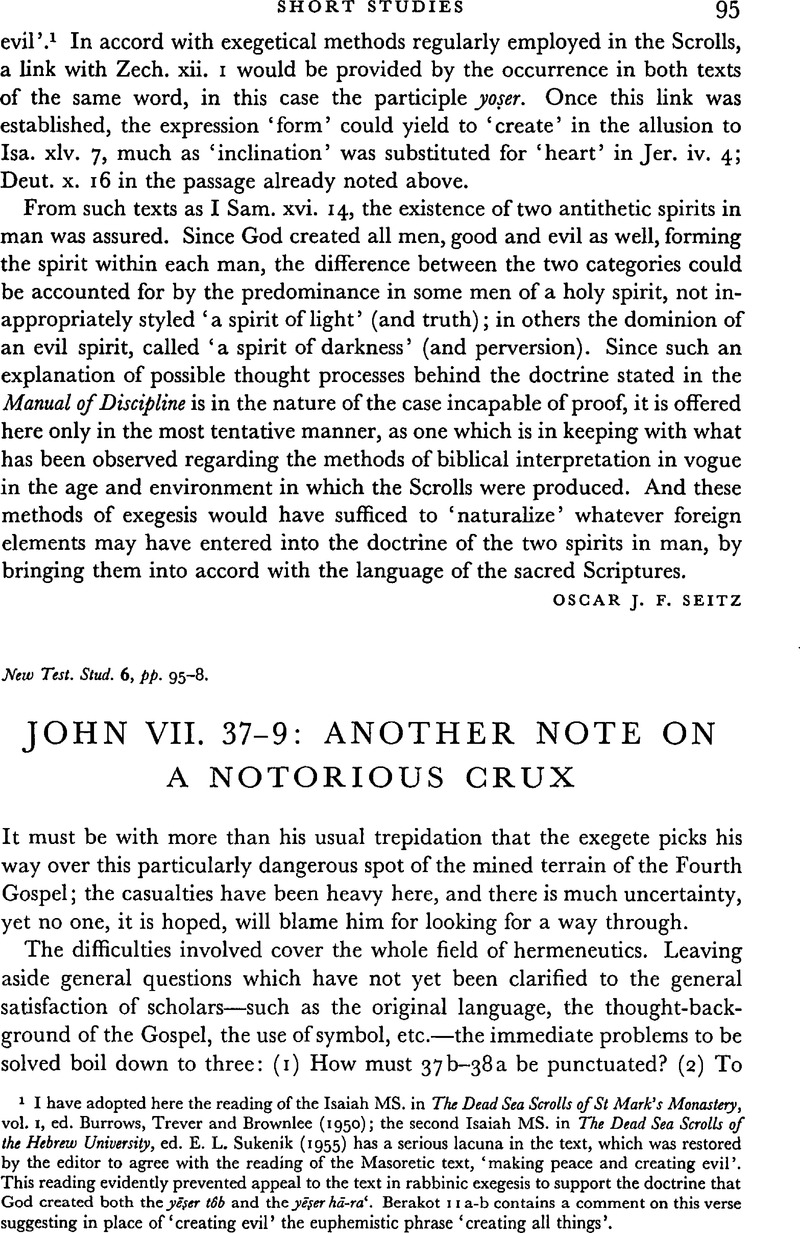No CrossRef data available.
Article contents
John VII. 37–9: Another Note on a Notorious Crux
Published online by Cambridge University Press: 05 February 2009
Abstract

Information
- Type
- Short Studies
- Information
- Copyright
- Copyright © Cambridge University Press 1959
References
page 95 note 1 I have adopted here the reading of the Isaiah MS. in The Dead Sea Scrolls of St Mark's Monastery, vol. 1, ed. Burrows, Trever and Brownlee (1950); the second Isaiah MS. in The Dead Sea Scrolls of the Hebrew University, ed. E. L. Sukenik (1955) has a serious lacuna in the text, which was restored by the editor to agree with the reading of the Masoretic text, ‘making peace and creating evil’. This reading evidently prevented appeal to the text in rabbinic exegesis to support the doctrine that God created both the yēşer tûb and the yē¸ser hā-rd'. Berakot 11 a-b contains a comment on this verse suggesting in place of ‘creating evil’ the euphemistic phrase ‘creating all things’.
page 96 note 1 Aramaic Origins of the Fourth Gospel (1922), pp. 109–13.Google Scholar
page 96 note 2 vi. 35 gives the clearest instance. Also iii. 20, ‘to come to the Light’, and v. 40, in a context which deals with believing.
page 96 note 3 Cf. John xii. 14; Rom. i. 17. In some cases, the formula follows the quotation, but again in syntactic isolation, for example John i. 23; Rom. ii. 24.
page 97 note 1 Bultmann, , Das Evangelium des Johannes (1950), p. 229.Google Scholar
page 97 note 2 Torrey, C. C., Our Translated Gospels (1936), p. 109.Google Scholar
page 97 note 3 Dodd, C. H., The Interpretation of the Fourth Gospel (1953), p. 349, n. 2.Google Scholar
page 98 note 1 In Numbers homily 12 (in Opera, ed. Delargue (1733), 11, 311); in Isaiah hom. 7 (op. cit. iii, 121); in Ezech. xxix. 3 (Op. cit. iii, 404); in Genesis hom. 10 (op. cit. ii, 87) where the two texts are quoted together as completing one another.
page 98 note 2 Starting from John vii. 38 Origen concludes: ‘You see then that he who believes in Him has not only one well but several, and not only springs but rivers within him’ (op. cit. ii, 311) and elaborates: ‘When God has manifested to those who believe (the Mystery of Christ) then all these will become springs and rivers in such a way that their gnosis is no longer hidden, but is offered to many… and it is for this reason, I believe, that the Saviour said to His disciples that whoever believes in Him and drinks His doctrine, there will be in him not just a well or a spring, but rivers of living water’ (op. cit. ii, 312).
page 98 note 3 In Numbers hom. 12 (op. cit. ii, 311).
page 98 note 4 On Ps. ii. 5 (op. cit. ii, 550).
page 98 note 5 See Rahner, ‘Flumina de Ventre Christi: die patristische Auslegung von Joh. vii, 37–8’, Biblica, xxii, 269 ff., 367ff.

